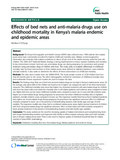| dc.contributor.author | K'Oyugi, BO | |
| dc.date.accessioned | 2015-02-16T08:21:22Z | |
| dc.date.available | 2015-02-16T08:21:22Z | |
| dc.date.issued | 2015 | |
| dc.identifier.citation | K'Oyugi BO. "Effects of bed nets and anti-malaria drugs use on childhood mortality in Kenya's malaria endemic and epidemic areas." BMC Public Health. 2015;15(34):1-9 | en_US |
| dc.identifier.uri | http://www.biomedcentral.com/content/pdf/s12889-015-1398-x.pdf | |
| dc.identifier.uri | http://hdl.handle.net/11295/80276 | |
| dc.description.abstract | Background: The Kenya Demographic and Health Surveys (KDHS) data collected since 1989 indicate that malaria
prone areas have consistently recorded the highest childhood mortality rates. Malaria control programme
information also indicates that malaria contributes to about 20 per cent of the deaths among under-five year old
children. The 2009–2017 National Malaria Strategy is being implemented to reduce malaria morbidity and mortality.
Its key interventions include: bed nets use; anti-malaria drugs use during pregnancy for prevention; and, prompt
treatment using anti-malaria drugs of children with fever. This study seeks to establish differentials in childhood
mortality rates by these interventions in three malaria prone areas defined as highland epidemic, coast endemic
and lake endemic. It also seeks to determine the effects of these interventions on childhood mortality.
Methods: The data used is drawn from the 2008/9 KDHS. The study sample consists of 3,728 children born less
than 60 months prior to the survey. The direct demographic method for estimation of childhood mortality rates
and multivariate Poisson regression models are used to analyse the data.
Results: The findings show that use of bed nets and anti-malaria drugs are not high in Kenya’s malaria prone areas. On
the average, only about 60% of the children are found to be in higher use category for each of the three intervention
measures. The childhood mortality rates show that higher use of prompt treatment with anti-malaria drugs for children
with fever has lower infant and under-five mortality rates in all malaria epidemic and endemic areas compared to lower
use. Higher bed nets use has lower childhood mortality rates compared to lower use in coast and lake endemic areas.
Higher use of anti-malaria drugs during pregnancy for prevention has lower childhood mortality rates in highland
epidemic and lake endemic areas compared to lower use. The regression models fitted show that in highland epidemic
area, higher use of anti-malaria drugs during pregnancy for prevention has significant reduction effect on childhood
mortality compared to lower use in the presence of breastfeeding duration, toilet facility type and age of child
variables. The regression models also show that in combined malaria prone areas, higher prompt treatment of children
with fever using anti-malaria drugs has significant reduction effect on both infant and child mortality compared to
lower prompt treatment in the presence of breastfeeding duration and toilet facility type variables.
Conclusion: This study underscore the need for increasing uptake of malaria interventions and complementing them
with longer breastfeeding duration and improved toilet facility in efforts towards reducing infant and child mortality
rates in Kenya’s malaria prone areas. There is also need to improve quality of individual household data for malaria
module in future KDHS undertakings. | en_US |
| dc.language.iso | en | en_US |
| dc.publisher | University of Nairobi | en_US |
| dc.subject | Childhood mortality, Bed nets, Anti-malaria drugs, Malaria epidemic and endemic, Kenya | en_US |
| dc.title | Effects of bed nets and anti-malaria drugs use on childhood mortality in Kenya's malaria endemic and epidemic areas. | en_US |
| dc.type | Article | en_US |
| dc.type.material | en | en_US |

